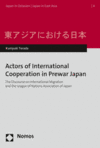Actors of International Cooperation in Prewar Japan
The Discourse on International Migration and the League of Nations Association of Japan
Abstract
The book is the first study on the history of one of the most powerful semi-governmental international organizations in interwar Japan: the League of Nations Association of Japan. Established in 1920 for the purpose of achieving the spirit of the League of Nations, the association was at the center of Japanese international cooperation and, even after Japan’s withdrawal from the League itself, acted vigorously as a member of the non-governmental International Federation of League of Nations Societies. Based on extensive multi-archival research, this book explores how members of the association including both governmental and non-governmental actors tried to address international problems such as racial equality, migration, labour, and population. By doing so, the book reconstructs a little-known history of Japan’s international cooperation and puts it into the context of global history.
Zusammenfassung
Der Band ist die erste englischsprachige Studie über die Geschichte und Hintergründe der japanischen Unterstützung des Völkerbundes. Diese wurde 1920 in einer der mächtigsten semistaatlichen internationalen Organisationen im Zwischenkriegsjapan organisiert: der League of Nations Association of Japan. Gegründet mit der Absicht, die Ziele des Völkerbundes zu verwirklichen, stand der Verband im Mittelpunkt der internationalen Zusammenarbeit Japans und trat auch nach dem Rückzug des Landes aus der League of Nations weiterhin als Mitglied der nichtstaatlichen Internationalen Föderation der Völkerbund-Gesellschaften auf. Basierend auf umfangreichen Quellen in japanischer, englischer, deutscher und französischer Sprache untersucht diese Studie, wie Mitglieder der Vereinigung, darunter staatliche und nichtstaatliche Akteure, versucht haben, internationale Probleme wie Rassengleichheit, Migration, Arbeit und Bevölkerung anzugehen. Auf diese Weise rekonstruiert der Band eine wenig bekannte Seite der Geschichte der internationalen Zusammenarbeit Japans und stellt sie in den Kontext der Weltgeschichte.
Schlagworte
- Kapitel Ausklappen | EinklappenSeiten
- 1–16 Titelei/Inhaltsverzeichnis 1–16
- 17–18 Note on Japanese names and the translation of Japanese texts 17–18
- 19–36 Introduction 19–36
- The definition of international cooperation
- The characteristics of Japanese international cooperation
- The structure of this book
- 37–84 Part I: The development of international cooperation before the First World War 37–84
- Chapter 1: International community life and the limits on the freedom of immigration: Yamada Saburō’s view on international migration
- Yamada Saburō and the shin jōyaku jisshi junbi project
- A controversy over article 2 of the Civil Code
- Yamada and the Institut de droit international
- The IDI’s discussion about the admission of foreigners into a country
- Limits on the freedom of immigration
- Japanese immigration law
- Open questions
- 85–206 Part II: International cooperation after the foundation of the League of Nations 85–206
- Chapter 2: The problem of international migration and the League of Nations Association of Japan: 1919–1925
- The LNAJ and its relations with business and financial circles
- The LNAJ and its relationship with the Japanese government
- The LNAJ and its racial equality proposal
- Discussion of racial equality at the IFLNS
- The ILO intervention
- French proposal on the admission of foreigners into a country
- A defeat at the ninth Congress of the IFLNS
- The aftermath of the defeat
- Chapter 3: The Geneva World Economy Conference and the LNAJ: 1925–1927
- The LNAJ’s discussion about the World Economy Conference
- Three positions
- Discussion at the IFLNS
- The Japanese government’s attitude towards the Conference
- A middle-ground position
- The World Economy Conference and its results
- Change and persistence in the LNAJ’s activities
- 207–263 Part III: International cooperation at a crossroads 207–263
- Chapter 4: The birth of international scientific cooperation: Ueda Teijirō’s population study and its historical significance, 1927–1938
- Two campaigns that emerged after the World Economy Conference
- Two campaigns and the LNAJ
- A cautious approach towards immigration problems
- An upsurge in interests in international scientific cooperation
- Ueda Teijirō’s population studies
- From the population projection to the measurement of living standards
- International cooperation in the age of crisis
- 264–270 Conclusion 264–270
- 271–286 References 271–286
- Manuscript and document collections
- Newspapers and Magazines
- Published sources in Japanese
- Published sources in English, French, and German
- 287–290 Index of names 287–290


